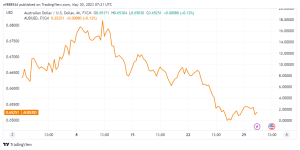AUDUSD is falling towards the round-level support at 0.6500.
In the early European session, the AUDUSD is falling towards the round-level support at 0.6500. The Australian currency has come under intense selling pressure. As the US Dollar Index (DXY) hit a new 10-week high of 104.45. On expectations that the Federal Reserve (Fed) will not end its policy-tightening cycle. In June and will continue to raise interest rates in order to keep a lid on stubborn US inflation.
S&P500 futures have steadily pared Monday’s gains in Asia. As investors fear that Tuesday’s trading session would be very turbulent following a long weekend. The overall market attitude has been cautious. As investors anticipate another interest rate hike from the Federal Reserve.
The US Dollar Index (DXY) has reclaimed its 10-week high after investors repurchased the currency. have moved their emphasis from the US debt-ceiling difficulties despite hopes. That it would be passed by Congress to the Federal Reserve’s monetary policy meeting in June. After noting resilience in consumer spending.
Meanwhile, the White House’s announcement of an increase in the US borrowing ceiling has put tremendous pressure on US Treasury rates. The yield on 10-year US government bonds has fallen below 3.77%.
The resilience of US consumer spending boosts hawkish sentiment.
Spending expenditure statistics released on Friday revealed. That US families are stubbornly cutting their spending. Despite the Federal Reserve’s increased interest rates and rising cost of living. The Personal Consumption Expenditure (PCE) Price Index, the Federal Reserve’s chosen inflation indicator. Returned strongly. The monthly cover and In April, core PCE inflation increased by 0.4%.
In addition, monthly Personal Spending data increased by 0.8%, compared to projections of 0.4%. And the previous expansion rate of 0.1%. Personal Income was 0.4%, which was in line with estimates. This suggests that consumer spending is deepening dramatically, forcing the Federal Reserve (Fed) to stay hawkish in the future.
The US labor market will serve as the foundation for the Federal Reserve’s monetary stance.
The publication of US employment statistics this week will offer a foundation for Federal Reserve officials in drafting June’s monetary policy stance. The Employment data will begin with the release of US JOLTS Job Openings data on Wednesday.
The economic data is expected to dip to 9.35M from 9.59M in the previous edition. This means that business activity has stalled. Because of the grim economic outlook, they have slowed their hiring process.
Later in the month, the US Automatic Data Processing (ADP) Employment Change (May) will be highlighted. According to consensus, the US economy added 170K new jobs in May, down from 269K the previous month. The week will conclude with Nonfarm Payrolls (NFP) data, which will be critical.
An overall improvement in labor market circumstances might mitigate the impact of consumer spending resilience, allowing the Federal Reserve to return to neutral interest rate policy.
Australian inflation will be kept under the spotlight.
The Australian Dollar is expected to surge following the announcement of the Australian monthly Consumer Price Index (April), which is planned for Wednesday. The economy is expected to recover to 6.4%. 6.3% higher than the previous release. Investors should be aware that the Australian monthly CPI has rapidly declined in the last four months, from a high of 8.4% in December to 6.3% in March. Earlier, Australian retail sales were static as rising living costs ate through families’ deep budgets.
Aside from that, the speech of Reserve Bank of Australia (RBA) Governor Philip Lowe will be closely observed. Lowe of the Reserve Bank of Australia is likely to provide interest rate advice for the June policy meeting.
Technical Outlook for the AUDUSD.
Market players liquidated the AUDUSD when it tested the breakout zone of the protracted consolidation around 0.6560 on a four-hour period.

The consolidation occurred in a wide range of 0.6562-0.6810, during which inventory was adjusted.
The Strength Index (RSI) (14) has fallen into the negative zone of 20.00-40.00, indicating further decline.








